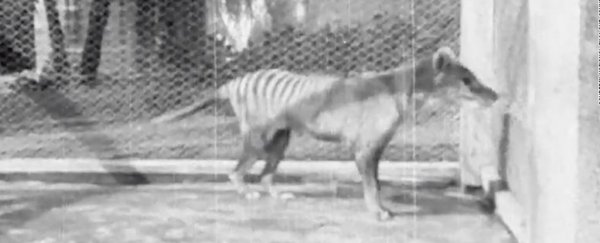Editor's note (12 December 2022): This article contains errors regarding the last known thylacine, which was not in fact an animal known as Benjamin, nor did it die of exposure, as is sometimes reported. For the sake of transparency, the original article is published here in its original form. ScienceAlert regrets the errors. More information is available here.
In 1936, Benjamin, the last known thylacine (Thylacinus cynocephalus), died from exposure in an Australian zoo.
Only the year before, he was being filmed for the long-forgotten travelogue Tasmania the Wonderland by the prolific Brisbane-based filmmaker Sidney Cook.
Today, just a few scenes of the travelogue survive: a double-decker tram system, Hobart's Sandy Bay beach, the long gone Beaumaris Zoo, and one of Australia's most famous extinct predators, the species widely known as Tasmanian tigers.
Benjamin's moment of fame lasts for only 21 seconds, but in the grand scheme of things that's practically a gold mine of video. Before this discovery, humans had little more than three minutes of silent black-and-white footage of thylacines.
Not only does this clip include audio, according to the National Film and Sound Archive of Australia (NFSA), the newsreel is the last known footage of the Tasmanian tiger.
Unseen by the public for 85 years, the clip has now been digitised in 4K and released online, to remember these enigmatic animals by.
As far as we know, this is the last time Benjamin or any other thylacine was caught moving on camera.
We have released 21-second newsreel clip featuring the last known images of the extinct Thylacine, filmed in 1935, has been digitised in 4K and released.
— NFSA National Film and Sound Archive of Australia (@NFSAonline) May 19, 2020
Be sure to check out the footage of this beautiful marsupial. #NFSAOpenOnline #TasmanianTigerhttps://t.co/s3JSAnmFck pic.twitter.com/FSRYXCTTMy
Even though the species has been gone for many decades, people are always holding out hope - if only for more lost audiovisuals documenting these creatures. In this case, members of the archive say they "remain optimistic that further footage may well surface in other collections."
The only videos of Tasmanian tigers so far were taken at zoos in Australia and London, but thylacines were sent to many parts of the world even after the arrival of this particular Cook film.
"While the NFSA holds preservation film copies of much of the known surviving footage of the thylacine, the search continues," a press release from the archive reads.
"Remaining to be uncovered are footage of a thylacine in colour, roaming in the wild or – most hopefully – film with location sound that reveals any sound made by the animal."
Such footage would give us unprecedented insight into this now extinct carnivore, which we know so little about. Now, unfortunately, our chance to marvel at Benjamin in real life has long passed us by, although some scientists have been attempting to sequence the species' genes and reconstruct their brains.
Nothing will ever match the real thing, though. Watching Cook's short clip, it's hard to not feel like shaking the zoo-goers like they are shaking Benjamin's cage.
In the background, the narrator can be heard explaining that the Tasmanian tiger "is now very rare, being forced out of its natural habitat by the march of civilisation."
Perhaps Benjamin's story is something we can still learn from today.
